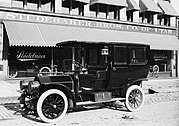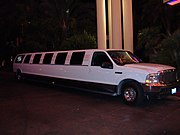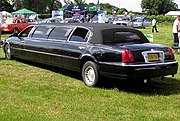









limousine (or limo) is a longer than normal luxury car. The chassis may have been extended by the manufacturer or by an independent coach builder, traditionally black or white in color. Limousines are most commonly driven by chauffeurs and until the mid-1990s were most often associated with the wealthy. They are also used for special occasions such as weddings, parties and sight-seeing tours.
While some limousines are owned by individuals, many are owned by governments to transport senior politicians, by large companies to transport executives, or by broadcasters to transport guests[citation needed]. Most limousines, however, operate as livery vehicles, providing upmarket competition to taxicabs.
History

The first automobile limousine, built in 1902, was designed so the driver sat outside under a covered compartment.[1] The word limousine is derived from the name of the French region Limousin, because this covered compartment physically resembled the cloak hood worn by the shepherds there. An alternate etymology has the chauffeur wearing a Limousin-style cloak in the open driver's compartment, for protection from the weather.[2][3][4]
The first “Stretch Limousine” was created in Fort Smith, Arkansas around 1928 by a coach company named Armbruster. These cars were primarily used to transport famous “big band” leaders, such as Glenn Miller and Benny Goodman, and their bands and equipment. These early stretch limousines were often called “big band buses”.[5]
[edit] Limousine types
A limousine has a divider separating the driver from the rear passenger compartment.[2] This partition usually contains a sliding (often soundproof) glass window so that conversations between passengers in the rear compartment may be kept private from the chauffeur. Communication with the driver is possible either by opening the window in the partition or by using an intercom system.
[edit] Traditional
Traditionally, the limousine has been an extension of a large sedan. A longer frame and wheelbase allow the rear passenger compartment to contain the usual forward facing passenger seat but with a substantial amount of footroom — more than is actually needed. Usually then two "jump seats" are mounted, facing rearward behind the driver. These seats fold up when not in use. In this way, up to five persons can be carried in the aft compartment in comfort, and up to two additional persons carried in the driver's compartment, for a total capacity of seven passengers in addition to the driver. This type of seat configuration has however become less popular in recent limousines.
[edit] Modern Limousines
Newer limousines such as the Maybach 62, Audi A8L, Mercedes-Benz S-Class, Hummer H2, Leyland Miracle, BMW 760Li , Lincoln Town Car;L Edition,and the Cadillac DTS do not feature such seats since stretch limousines are usually used to transport more than three passengers, excluding the driver. In production American limousines however, the jump seats almost always faced forward. The last production limousine, by Cadillac, with forward facing jump seats was in 1987, the last Packard in 1954, and the last Lincoln in 1939, though Lincoln has offered limos through their dealers as special order vehicles from time to time. Vehicles of this type in private use may contain expensive audio players, televisions, video players, and bars, often with refrigerators.
It is simpler and more straightforward to determine the effects of altering a separate chassis than it is to determine the effects of altering a load-bearing unit body. For this reason, the automobile of choice for conversion into stretch limousines is the Lincoln Town Car, whose Panther platform is one of the last remaining automotive platforms using a separate load-bearing chassis.[citation needed] However, coachbuilders have recently built many new models based on SUVs with separate load-bearing chassis, including Hummer H2s and H3s.
[edit] Stage
Another type of vehicle modified for multiple passenger use is the motorized stage, applied to the same tasks as the earlier stagecoach. It is not considered a true limousine but rather in its design and application is between a sedan and a bus. While a bus will have a central interior aisle for access to seating, a stage has multiple doors that allow access to transverse forward facing seats. Examples of the type were constructed not only from sedans (e.g., Chrysler New Yorker, Cadillac DeVille), but also from station wagons; many of the station wagon conversions sported a large rack, running the length of the roof, for carrying the passengers' baggage.
This type of vehicle was once rather common in some locations. An example of its use was in the transport of travelers arriving by railroad at Merced, California to Glacier National Park and Yosemite National Park in the first half of the 20th century. In Glacier National Park, these were referred to as "Jammers" in reference to the nickname of their gear-jamming drivers. In Yosemite, passengers would then stay in rustic platform tent camps or more expensive lodges and hike or rent bicycles for movement around the park.
A modern version of the stage is seen in some novelty stretch Hummer or Hummer H2 vehicles. Some funeral homes maintain six-door stages to carry the family of the deceased between the church and the cemetery. These are usually not used for private hire.
[edit] Exotic limousines

Sometimes a coach builder or car designer will develop the "ultimate" stretch limo, adding amenities that are somewhat impractical but which make a significant design statement. One such design includes double rear axles to support the weight of an operational hot tub.
Coach builders can perform aftermarket extensions on luxury sedans and SUVs. These extensive limousine conversions have been performed on several luxury marques, including: Audi, Bentley, BMW, Cadillac, Chrysler, Ford, Holden, Hummer, Infiniti, Jaguar, Lexus, Lincoln, Mercedes-Benz, Rolls-Royce and Volkswagen. In the United States the most popular vehicles for stretch limousines conversion are the Lincoln Town Car, Cadillac DTS, Hummer H2, Ford Excursion, and the Lincoln Navigator. There are even instances of Corvettes and VW Beetles being stretched to accommodate up to 10 passengers.
Most custom coach builders are located in the United States and Europe and cater mainly to limousine companies. Few such vehicles are available for public hire. A typical price to buy a Lincoln Town Car sedan and have it stretched to hold 6 passengers is approximately USD $85,000 (at 2006 prices) depending on the additional features added into the vehicle. In addition to luxuries, security features such as armoring and bulletproof glass are available.
| Winton Six Limousine, 1915. Note that the driver is in a compartment separate from the passengers, a distinctive limousine feature. | Lincoln Limousine used by U. S. President Calvin Coolidge, c. 1924 | A Lada "limousine" in Trinidad, Cuba |






No comments:
Post a Comment